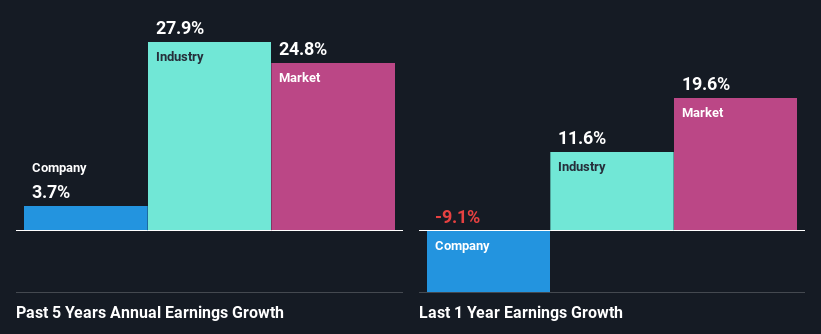- India
- /
- Auto Components
- /
- NSEI:EXIDEIND
Are Exide Industries Limited's (NSE:EXIDEIND) Mixed Financials Driving The Negative Sentiment?
With its stock down 12% over the past three months, it is easy to disregard Exide Industries (NSE:EXIDEIND). It seems that the market might have completely ignored the positive aspects of the company's fundamentals and decided to weigh-in more on the negative aspects. Fundamentals usually dictate market outcomes so it makes sense to study the company's financials. Specifically, we decided to study Exide Industries' ROE in this article.
Return on equity or ROE is an important factor to be considered by a shareholder because it tells them how effectively their capital is being reinvested. In other words, it is a profitability ratio which measures the rate of return on the capital provided by the company's shareholders.
How Do You Calculate Return On Equity?
The formula for return on equity is:
Return on Equity = Net Profit (from continuing operations) ÷ Shareholders' Equity
So, based on the above formula, the ROE for Exide Industries is:
5.8% = ₹8.0b ÷ ₹138b (Based on the trailing twelve months to December 2024).
The 'return' is the yearly profit. Another way to think of that is that for every ₹1 worth of equity, the company was able to earn ₹0.06 in profit.
View our latest analysis for Exide Industries
What Is The Relationship Between ROE And Earnings Growth?
So far, we've learned that ROE is a measure of a company's profitability. We now need to evaluate how much profit the company reinvests or "retains" for future growth which then gives us an idea about the growth potential of the company. Assuming all else is equal, companies that have both a higher return on equity and higher profit retention are usually the ones that have a higher growth rate when compared to companies that don't have the same features.
Exide Industries' Earnings Growth And 5.8% ROE
As you can see, Exide Industries' ROE looks pretty weak. Even when compared to the industry average of 12%, the ROE figure is pretty disappointing. Thus, the low net income growth of 3.7% seen by Exide Industries over the past five years could probably be the result of it having a lower ROE.
As a next step, we compared Exide Industries' net income growth with the industry and were disappointed to see that the company's growth is lower than the industry average growth of 28% in the same period.

The basis for attaching value to a company is, to a great extent, tied to its earnings growth. The investor should try to establish if the expected growth or decline in earnings, whichever the case may be, is priced in. This then helps them determine if the stock is placed for a bright or bleak future. If you're wondering about Exide Industries''s valuation, check out this gauge of its price-to-earnings ratio , as compared to its industry.
Is Exide Industries Making Efficient Use Of Its Profits?
Exide Industries has a low three-year median payout ratio of 20% (meaning, the company keeps the remaining 80% of profits) which means that the company is retaining more of its earnings. However, the low earnings growth number doesn't reflect this fact. So there could be some other explanation in that regard. For instance, the company's business may be deteriorating.
Moreover, Exide Industries has been paying dividends for at least ten years or more suggesting that management must have perceived that the shareholders prefer dividends over earnings growth. Based on the latest analysts' estimates, we found that the company's future payout ratio over the next three years is expected to hold steady at 17%. Regardless, the future ROE for Exide Industries is predicted to rise to 9.4% despite there being not much change expected in its payout ratio.
Conclusion
In total, we're a bit ambivalent about Exide Industries' performance. Even though it appears to be retaining most of its profits, given the low ROE, investors may not be benefitting from all that reinvestment after all. The low earnings growth suggests our theory correct. Having said that, looking at the current analyst estimates, we found that the company's earnings are expected to gain momentum. To know more about the company's future earnings growth forecasts take a look at this free report on analyst forecasts for the company to find out more.
Valuation is complex, but we're here to simplify it.
Discover if Exide Industries might be undervalued or overvalued with our detailed analysis, featuring fair value estimates, potential risks, dividends, insider trades, and its financial condition.
Access Free AnalysisHave feedback on this article? Concerned about the content? Get in touch with us directly. Alternatively, email editorial-team (at) simplywallst.com.
This article by Simply Wall St is general in nature. We provide commentary based on historical data and analyst forecasts only using an unbiased methodology and our articles are not intended to be financial advice. It does not constitute a recommendation to buy or sell any stock, and does not take account of your objectives, or your financial situation. We aim to bring you long-term focused analysis driven by fundamental data. Note that our analysis may not factor in the latest price-sensitive company announcements or qualitative material. Simply Wall St has no position in any stocks mentioned.
About NSEI:EXIDEIND
Exide Industries
Designs, manufactures, markets, and sells lead acid storage batteries in India and internationally.
Excellent balance sheet with limited growth.
Similar Companies
Market Insights
Community Narratives



